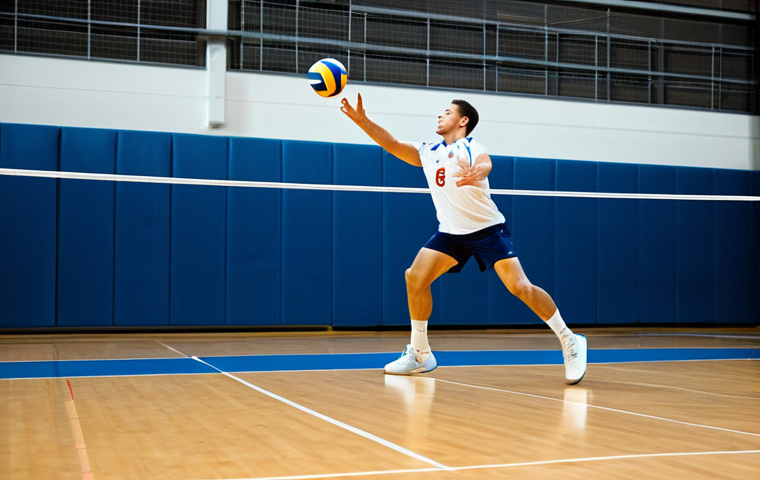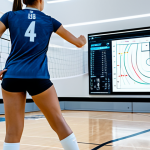You know that electrifying moment when the ball rockets over the net, untouched, slamming straight onto the opponent’s floor for a clean ace? The roar of the crowd, the surge of adrenaline – there’s truly nothing quite like it in volleyball.
I’ve spent countless hours on the court, battling for that perfect serve, feeling the frustration of a missed opportunity, and the sheer elation when it all clicks.
It’s not just about brute power anymore; with today’s advanced defensive strategies and analytics, a successful ace demands precision, strategic placement, and an almost intuitive understanding of court dynamics.
We’re living in an era where data-driven insights are reshaping every aspect of the game, pushing servers to master not just their technique, but also their mental game under pressure.
Forget those generic tips; truly mastering the art of the service ace means understanding the subtle nuances that separate a good serve from a truly unreturnable one.
It’s a journey of continuous refinement, where every toss, every contact, and every follow-through counts. Let’s find out more in the article below.
Beyond Raw Power: The Strategic Evolution of the Service Ace

You know, for the longest time, especially when I was first starting out, I genuinely believed that a service ace was all about how hard you could hit the ball. Just wind up, unleash all your fury, and hope it flies past them. Boy, was I wrong! I remember a particular game, probably five years back, where I was serving against a team that seemed to anticipate every bomb I sent over. No matter how much muscle I put into it, their libero just seemed to float under it effortlessly, digging everything up. It was incredibly frustrating. That game was a wake-up call for me. It wasn’t about brute force; it was about outsmarting the opponent. Today, the landscape of volleyball has shifted dramatically. Defensive systems are incredibly sophisticated, with teams employing advanced blocking schemes and highly trained back-row players who read serves like open books. Simply hitting it hard isn’t enough; you’re just giving them a free pass to set up their offense. The modern service ace is a testament to strategic brilliance, a chess match played at lightning speed. It requires a nuanced understanding of not just your own capabilities, but also the opposing team’s vulnerabilities, their receive patterns, and even individual player tendencies. It’s about precision, deception, and calculated risks, not just raw, unadulterated power. I’ve personally spent hours analyzing game footage, dissecting serve receives, and charting zones to find those sweet spots that force an error or a shank. This evolution is what makes the ace so much more rewarding now—it’s not just an athletic feat, but a mental one too.
1. Deconstructing the Opponent’s Receive Formation
- The first step in any strategic serve is to deeply understand how the opposing team sets up their receive. Do they typically run a five-man receive, or a four-man with a setter or hitter pulled back? What are their common rotations for receive? I’ve found that watching their warm-ups can often give you subtle clues. Are they running specific drills that emphasize a certain type of receive? Pay close attention to who the primary passers are – usually, it’s the libero and the outside hitters. Who looks uncomfortable or less fluid during these drills? That’s your potential target.
- Once you’ve identified their formation, you can start to pinpoint the “seams” – those tricky areas between two passers, or the deep corners where communication might break down. These are often the most difficult balls to receive cleanly. When I’m on the service line, I’m not just seeing a group of players; I’m seeing a diagram of their receive, looking for the gaps.
2. Exploiting Rotational Weaknesses and Player Tendencies
- Every player has a preference, a comfort zone, and, inevitably, a weakness. Some liberos hate a hard-driven float serve right at their face, while others struggle with deep topspins that push them back. For example, I played against a team once where their best passer was incredibly strong on deep serves but struggled with short, sharp topspins that dropped just over the net. My coach pointed this out, and suddenly, my short serves, which I rarely used for aces, became my most effective weapon against them. It felt almost unfair, like I had a secret decoder ring.
- You need to constantly scout and adapt. Who’s covering the deep zones? Who’s hesitant on cross-court receives? Is their setter unusually slow to get to the ball if they have to take the first touch? These observations, gathered through diligent study or even just gut feeling during a game, become your playbook for the serve. It’s about creating discomfort for them, forcing them into positions where they are less effective.
Mastering the Arsenal: Beyond the Basic Float and Topspin
When I first started playing, my serve repertoire consisted of pretty much two options: a float serve that sometimes floated and sometimes didn’t, and a topspin that usually went out. It was a very limited, very predictable toolkit. But as I watched seasoned players, I realized that true serving mastery wasn’t just about perfecting one or two serves; it was about having an entire arsenal at your disposal. Each serve type has its own unique characteristics, its own ‘personality,’ if you will, and its own ideal application. The float serve, when executed perfectly, is a thing of beauty – it knuckles, it dips, it dances unpredictably, making it incredibly hard to track. Then there’s the topspin, a powerful beast that dives sharply, forcing a quick, often awkward receive. But there’s so much more! I’ve spent countless hours in practice, sometimes hitting hundreds of serves in a single session, not just to get them over, but to control their trajectory, their speed, and their spin. It’s about knowing when to pull out the deceptively slow floater, or when to unleash a lightning-fast jump serve that screams through the air. You need to develop a feel for each serve, understanding its flight path and how it interacts with air resistance. This variety keeps the opponent guessing and prevents them from settling into a comfortable receive rhythm. It’s a dynamic interplay between different forces, all orchestrated by your hand. Trust me, the moment you start to feel confident in a variety of serves, your ace potential skyrockets.
1. The Art of the Deceptive Float Serve
- The float serve is perhaps the most underestimated weapon in volleyball. It’s not about power, but about finesse and deception. The goal is to hit the ball with absolutely no spin, causing it to “float” or “knuckle” unpredictably through the air. I remember my first coach always saying, “Hit the sweet spot, then stop your hand like it’s frozen.” It sounds simple, but achieving that dead contact requires immense precision and a consistent toss. The real trick, I’ve found, is to make every float serve look identical until the very last second. This visual consistency prevents the opponent from reading your intention early.
- A common mistake I used to make was trying to guide the ball. You can’t guide a float; you just hit it perfectly and let the air do the rest. The key is to keep your eyes fixed on the point of contact, ensure a flat hand, and a clean, quick snap. When it works, it’s magical – the ball seems to suddenly dip or swerve at the last moment, causing the receiver to misjudge it just enough for an ace.
2. Unleashing the Power and Precision of the Topspin Serve
- The topspin serve is a different beast entirely. It’s about generating massive forward rotation, causing the ball to dive sharply down onto the opponent’s side. This serve is often associated with high velocity and a strong attack. My personal journey with the topspin was a struggle initially; I could hit it hard, but it rarely stayed in bounds. I eventually learned that the true power comes from a full body coil and an explosive unwinding, driving through the ball with a high, accelerating contact point.
- The follow-through is critical – you need to “snap” over the top of the ball, almost like you’re wiping down the front of it, pulling your hand through to generate that heavy topspin. This sharp downward trajectory makes it incredibly difficult for passers to get their platform under the ball cleanly, often leading to shanks or uncontrolled passes. It also has a distinct sound and feel, a satisfying thud that screams “power.”
3. Introducing the Jump Float and Other Specialized Serves
- Beyond the basic float and topspin, there are advanced variations like the jump float, which combines the unpredictability of a float with the speed and trajectory of a jump serve, giving the receiver even less time to react. I’ve personally incorporated this into my game, and the initial learning curve was steep, but the payoff has been huge. It adds another layer of complexity for the defense.
- Then there’s the hybrid serve, or even serves with side spin, designed to curve into or away from a passer. Experimenting with these lesser-used serves can give you a significant edge, as opponents may not be accustomed to receiving them. It’s about diversifying your attacks and constantly surprising the defense.
The Mental Game: Composure Under Pressure
I can tell you from personal, agonizing experience that having the perfect technique means absolutely nothing if your head isn’t in the game. I’ve been there, standing on the service line, heart pounding, the weight of the match resting on my shoulders, and completely choking. My hands would get clammy, my toss would go awry, and the ball would sail out or into the net. It’s a terrible feeling. Mastering the service ace isn’t just a physical endeavor; it’s profoundly psychological. The pressure is immense, especially in tight game situations or when you’re down by a few points. Opponents are yelling, the crowd is roaring, and suddenly, that perfectly consistent toss you practiced a thousand times feels alien. This is where mental fortitude becomes your superpower. It’s about cultivating a mindset that allows you to block out distractions, remain calm, and execute your serve with precision, regardless of the scoreboard or the noise. I’ve learned over the years that my pre-serve routine is my anchor, a little ritual that brings me back to center. It’s not just about what you do physically, but how you manage your thoughts and emotions during those critical seconds. Every successful ace is as much a victory of the mind as it is of the body.
1. Developing a Consistent Pre-Serve Routine
- This is perhaps the single most important mental tool I’ve adopted. My routine starts the moment I receive the ball. I take a deep breath, bounce the ball three times, visualize the target, and then focus purely on my toss. It’s a sequence of actions that I perform identically before every single serve, regardless of the situation. This consistency helps to quiet the noise in my head and brings me into a state of focused readiness.
- The routine acts as a mental trigger, telling your brain, “It’s game time. Focus.” Even if I’m feeling flustered, going through the motions of my routine helps me reset and get back into my zone. I’ve seen some players spin the ball a certain number of times, others tap their feet. Find what works for you, and stick with it.
2. Visualization and Positive Affirmations
- Before I even step onto the court, I spend time visualizing perfect serves. I imagine the ball hitting the target, the opponent struggling to receive it, the satisfying thud of the ace. This isn’t just wishful thinking; it’s a powerful mental rehearsal that primes your brain for success. During the game, especially between points, I’ll quickly re-visualize a successful serve before stepping up to the line.
- Combine visualization with positive self-talk. Instead of thinking, “Don’t mess this up,” tell yourself, “You’ve got this. Hit your spot.” This shift in internal dialogue can make a tremendous difference in your confidence and execution. I used to be my own worst critic, but I’ve learned to be my biggest cheerleader.
The Precision of Placement: Targeting Weaknesses and Seams
If there’s one thing that transformed my serve ace percentage from “lucky” to “strategic,” it was understanding the absolute critical importance of placement. It’s not enough to just get the ball over the net; you have to put it in a spot where it causes maximum disruption. I vividly recall a frustrating practice session where my coach had me serving into tiny hoops placed on the court. It felt impossible at first! But slowly, painstakingly, I started to develop the touch and control needed to hit those specific zones. It was a game-changer. An ace is often less about power and more about precision – finding that specific square foot of court that a receiver either isn’t covering, or is covering awkwardly. This means understanding receiver tendencies, identifying seams between players, and even exploiting the “shadows” of the court where players are less comfortable. Think about it: a ball hit perfectly into the deep corner, or a short serve that drops just over the net, can be just as effective as a rocket serve, sometimes even more so because it forces immediate, uncoordinated movement. It’s like being a sniper, meticulously aiming for the smallest target. This refined targeting comes from countless repetitions, building muscle memory for different serve trajectories, and a keen eye for court awareness. My goal now isn’t just to serve; it’s to make the receiver move in an uncomfortable way.
1. Identifying the Court’s “Sweet Spots” for Aces
- Every court has its hidden vulnerabilities. These often include the deep corners (zones 1 and 5), the short zones just over the net (zone 2 or 4, depending on the server), and, crucially, the seams between two receivers. The “seam” serve is particularly effective because it forces both players to make a decision – “Is it yours or mine?” – often leading to miscommunication or a weak contact. I’ve found that serving aggressively down the line into zone 1 or zone 5, especially if the opposing outside hitter is a weaker passer, can be incredibly effective.
- Another favorite of mine is the short serve that drops just over the net. This forces the front-row players, who are usually not primary passers, to take the first contact, disrupting their offensive flow. This also keeps the libero or primary passers from getting too comfortable in the back.
2. Leveraging Receiver Movement and Court Coverage
- As a server, you’re not just serving; you’re observing. Before you even toss the ball, take a quick glance at the opposing team’s receive formation. Are they spread out wide? Are they compact? Is one player deeper than the others? This informs your decision. If a player looks tentative or slow to move laterally, that’s your target for a serve that pulls them wide or forces them to shuffle.
- I’ve also learned to watch the setter. If the setter is in the front row and has to take the first pass, it immediately takes them out of their setting position, forcing an emergency set or an out-of-system play. This can be a huge disruption to their offense. It’s about creating chaos, one serve at a time.
Table: Key Serve Types and Their Strategic Application
Understanding when and how to use each serve type is crucial. This table breaks down the common serves and their ideal scenarios for generating an ace.
| Serve Type | Key Characteristics | Ideal Ace Scenario(s) | Receiver Vulnerabilities Exploited |
|---|---|---|---|
| Float Serve | No spin, unpredictable trajectory (knuckles, dips) | Targeting seams, short zones, or players who struggle with reading flight path | Poor footwork, misjudging ball’s final path, communication errors |
| Topspin Serve | Heavy forward spin, sharp downward trajectory, high velocity | Deep corners, forcing difficult body positions for passers, overwhelming weaker receivers | Struggling to get platform under ball, getting pushed off balance, weak first contact |
| Jump Float Serve | Combines jump serve speed with float serve unpredictability | Quickly overwhelming receivers, targeting seams with less reaction time, forcing quick decisions | Limited reaction time, difficulty adjusting to fast, knuckling ball |
| Jump Topspin Serve | High power, steep dive, often from a higher contact point | Breaking through organized receive, overwhelming single passers, hitting deep zones with force | Inability to absorb pace, getting trapped deep in court, poor passing angles under pressure |
Drills and Dedicated Practice: Honing Your Ace Touch
Let’s be real: natural talent is a great starting point, but it’s consistent, smart practice that truly refines your serving game. I remember countless hours spent in the gym, sometimes by myself, just hitting serve after serve. It wasn’t always glamorous; there were days when my arm felt like lead, and every ball seemed to go out. But those monotonous repetitions are exactly what build muscle memory and the precision needed for an ace. You can’t expect to show up on game day and magically hit aces without putting in the work. It’s about creating an environment where you can experiment, make mistakes without consequence, and gradually build the confidence and consistency required. Think of it like a painter learning their craft – they don’t just pick up a brush and create a masterpiece; they practice strokes, understand colors, and learn different techniques. Serving is no different. It requires dedication, a keen eye for self-correction, and a willingness to push through the frustrating moments. I’ve found that focusing on quality over quantity in practice, truly engaging with each serve, yields far better results than just mindlessly hitting balls.
1. Precision Target Practice
- Forget just serving the ball over the net. Set up specific targets on the opposing side of the court. Use cones, hula hoops, or even tape to mark out small zones (e.g., deep corners, short zones, seams between imaginary players). The goal is not just to get the ball in, but to hit that precise target. I often practice serving 10 balls into zone 1, then 10 into zone 5, then 10 short. This granular approach forces you to refine your aim and consistency for different types of serves and placements.
- Vary the type of serve you use for each target. For example, try to hit a float serve into a short zone, then a topspin into a deep corner. This builds a versatile skill set. Don’t be afraid to try “impossible” targets at first; that’s how you expand your capabilities.
2. Repetition with Purpose
- While volume is important, mindful repetition is key. Before each serve, visualize where you want the ball to go. After each serve, evaluate what happened. Was your toss consistent? Was your contact point ideal? Did the ball go where you intended? If not, identify why and make an adjustment on the next serve.
- I often record my serving sessions with my phone. Watching yourself back, even just for a few minutes, can reveal subtle flaws in your technique or routine that you might not notice in the moment. It’s like having a personal coach constantly analyzing your form.
3. Game-Like Pressure Drills
- Practicing under pressure is paramount. Simulate game situations in training. For instance, set up a drill where you need to hit three aces in a row to “win” the drill, or where you’re serving with a “score” tied at 24-24. Add a consequence for missing, like push-ups or sprints. This simulates the mental and physical stress of a real game and helps you build composure.
- Serving against live receive is also invaluable. Ask teammates to receive your serves, giving you immediate feedback on the difficulty of your serves and where they are effective or not. This is where you truly understand how your serves impact the opponent.
Recovery and Longevity: Keeping Your Arm Ace-Ready
Serving, especially with power and consistency, takes a significant toll on your body, particularly your shoulder and arm. I’ve learned this the hard way, pushing too hard without adequate recovery and feeling that familiar ache creep in. It’s not just about how many aces you can hit in a single game; it’s about how many you can hit throughout an entire season, or even an entire career. Neglecting proper recovery and arm care is a surefire way to sideline yourself, and trust me, there’s nothing more frustrating than wanting to play but being physically unable to. An ace is a beautiful thing, but a healthy, resilient arm is even more so. This means being diligent about warm-ups, cool-downs, stretching, and strength training specifically tailored for overhead athletes. It also means listening to your body and knowing when to back off. I used to think I was invincible, but a minor shoulder tweak taught me a painful lesson about respecting my limits. Longevity in this sport, and in serving especially, is about smart, sustainable training practices that prioritize the health of your most vital asset – your arm. It’s a long-term investment, not a short-term gamble.
1. Pre-Serve Warm-up and Dynamic Stretching
- Before every practice or game, a thorough warm-up is non-negotiable. This isn’t just a few arm circles. It involves dynamic stretching that prepares your rotator cuff, shoulder girdle, and entire upper body for the explosive movements of serving. I personally incorporate band work (internal/external rotations), light plyometric throws, and arm swings to get the blood flowing and muscles activated.
- A proper warm-up significantly reduces the risk of injury and ensures that your serve is firing on all cylinders from the very first ball. It’s like warming up a car engine before a race – you wouldn’t just floor it from cold, would you?
2. Post-Practice Recovery and Static Stretching
- After a serving session or a game, recovery is just as crucial as the warm-up. This includes static stretching to improve flexibility and reduce muscle soreness, foam rolling to release tension in the back and shoulders, and targeted cool-down exercises. I also swear by ice baths or cold packs for my shoulder if I’ve had a particularly heavy serving day.
- Adequate sleep and proper nutrition also play a massive role in muscle repair and overall recovery. You can’t expect your arm to perform consistently if you’re not fueling it and allowing it to rest.
3. Strength and Conditioning for Serving Longevity
- Beyond the immediate warm-up and cool-down, incorporating specific strength and conditioning exercises into your routine is vital for long-term arm health and power. This includes exercises that strengthen the rotator cuff, scapular stabilizers, and core muscles, all of which contribute to a powerful and injury-resistant serve.
- Resistance band exercises, light weights for shoulder health, and plyometrics can significantly enhance your serving power and reduce the risk of overuse injuries. I learned this from a physical therapist after a minor shoulder scare; it’s not about big, heavy lifts, but smart, targeted movements.
Concluding Thoughts
So, there you have it. The service ace, as I’ve come to understand it, is a beautiful symphony of physical prowess, strategic thinking, and unwavering mental fortitude.
It’s no longer just about unleashing raw power; it’s about outsmarting your opponent, perfecting your craft, and maintaining your composure when it matters most.
Embracing these facets has not only elevated my own game but has made every successful ace feel like a hard-earned victory. Keep practicing, keep analyzing, and most importantly, keep enjoying the strategic dance that is the modern volleyball serve.
You’ll be surprised at the aces you unlock.
Useful Information
1. Beyond just practicing serves, dedicate time to watching professional games with a critical eye. Pay attention to where and how top servers place their aces, and try to understand the strategic reasons behind their choices. This visual learning can unlock new ideas for your own game.
2. Don’t hesitate to seek out a specialized serving coach or attend a serving clinic. Even a small tweak to your toss or contact point from an experienced eye can lead to significant improvements and prevent bad habits from forming.
3. Integrate core strength and stability exercises into your training routine. A strong core is the foundation for a powerful and controlled serve, allowing you to transfer energy efficiently from your lower body through your arm.
4. Consider varying your approach to the service line. Sometimes, a slightly different starting position or angle can open up new serving lanes and keep your opponents guessing, even if your serve type remains the same.
5. Remember that consistency often trumps raw power, especially at lower levels. Focus on getting your serves in consistently with good placement before trying to add maximum velocity. An in-play serve, even if slower, forces a receive and allows your defense to set up.
Key Takeaways
The modern service ace is a blend of strategy, diverse technique, and mental strength. Deeply understand your opponent’s receive patterns and individual weaknesses.
Develop an arsenal of serves (float, topspin, jump float, etc.) to keep opponents guessing. Mental preparation, including routines and visualization, is crucial for pressure situations.
Consistent, targeted practice and smart arm care are non-negotiable for improvement and longevity.
Frequently Asked Questions (FAQ) 📖
Q: Beyond brute power, what’s really key to landing those unreturnable aces in today’s game, especially with all the advanced defense and data out there?
A: Oh, man, it’s such a different beast now than even just a decade ago. It’s not just about how hard you hit it; it’s like a chess match with a ball. For me, the real game-changer has been honing that “intuitive understanding of court dynamics.” I remember this one match, we were down two sets, and I just had this gut feeling, almost a whisper, to aim for the deep corner, knowing their libero tended to cheat slightly left.
My coach was probably thinking I was nuts, but I went for it, and boom! Ace. The ball just died on the line.
Nowadays, you layer that intuition with the data — seeing patterns in opponent reception, knowing where they struggle with float serves versus topspin.
It’s about merging your feel for the game with the numbers, finding those tiny windows of opportunity that make a serve truly unreturnable, not just powerful.
It’s like having a superpower that’s part instinct, part studied intelligence.
Q: You mentioned ‘mental game under pressure’ and ‘continuous refinement.’ What’s one practical tip for a player looking to elevate their serve, not just mechanically, but truly making it a weapon in clutch moments?
A: Okay, this is where so many players crumble, right? That moment when the game’s on the line, and your hand feels like it weighs a thousand pounds. My absolute go-to is visualization – and I mean detailed visualization.
Before every serve, especially in pressure situations, I close my eyes for just a second, breathe deeply, and vividly imagine the entire sequence: the toss, the contact point, the ball flying exactly where I want it to go, and the opponent scrambling, unable to reach it.
I even picture the satisfying thud of the ball hitting the floor. It sounds a bit woo-woo, but it calms my nerves and programs my body for success. I’ve seen it work wonders; it’s about tricking your brain into believing you’ve already aced it a hundred times before you even toss the ball.
That ‘continuous refinement’ isn’t just about technique, it’s about refining that mental muscle, too. It’s how you keep your cool when the crowd is roaring and your teammates are looking to you.
Q: How exactly are ‘data-driven insights’ reshaping serving strategy? Does that mean I need to be a tech guru just to hit a good serve now?
A: Absolutely not! You don’t need to be a tech guru; think of it more like having a really smart scout. For me, data insights are all about understanding your opponents’ weaknesses before you even step on the court.
It’s like knowing their playbook. We’re talking about tracking where opposing teams tend to receive poorly, identifying their weakest passer, or even seeing patterns in how their setters move after a certain type of serve.
For example, if the data shows a particular team struggles significantly with deep float serves to zone 1, you’re not just serving randomly; you’re serving with purpose, targeting a known vulnerability.
It’s not about replacing skill; it’s about enhancing it. Instead of just trying to hit the ball hard and hope, you’re hitting it with a laser focus, informed by actual evidence.
It gives you a massive psychological edge, knowing you’re not just guessing, you’re executing a calculated attack. It’s like having X-ray vision for the court, without needing to wear any special goggles.
📚 References
Wikipedia Encyclopedia
구글 검색 결과
구글 검색 결과
구글 검색 결과
구글 검색 결과
구글 검색 결과





